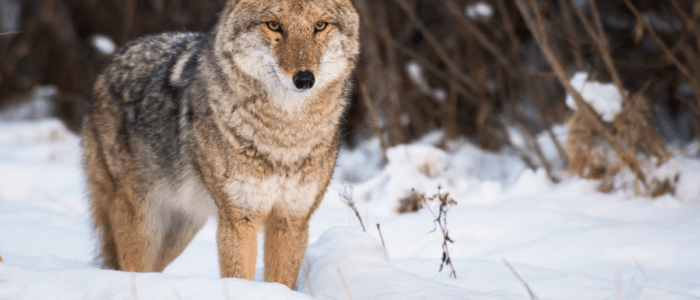What To Do If A Coyote Shows Up In Your Neck Of The Woods
The SOS 4 Kids team prioritizes safety. We are especially passionate about teaching children how to keep safe at all times. Arguably, an important time of the day to be safety conscious is during those walks to and from school or when playing outside. Any time children are outdoors, a focus on safety is paramount. This is especially true in areas where coyotes may be present.
Southern Ontario is home to many coyotes.
As Discover Southern Ontario informs us, coyotes “are most common in areas that are adjacent to green spaces, such as farm land, conservation areas and parks. They can travel a long way using ravines, highways and roads, walking paths and hydro corridors, although they prefer to build their dens in secluded places where they will not be disturbed – in ravines or close to the banks of streams and small rivers.”
Coyotes are intelligent and adaptable animals. They are not usually threats to human safety. However, it’s certainly important to practice safety measures if a coyote shows up in your neck of the woods.
Do not approach.
Coyotes resemble wolfdogs and huskies. This combination can cause your child to mistake a coyote for a neighbourhood pet. It’s important to educate your young ones about how to interact with any animal they see in their neighbourhood. The key word, of course, is “don’t”. Ensure that your kids never attempt to approach a coyote.
“Do not approach coyotes, their dens, or their pups, even if it appears the parents are not in the vicinity,” warns Coyote Watch Canada, “Coyotes will do their best to avoid humans but may interact with humans when provoked (during risky human behaviour such as feeding, interfering with pups or harassing) sick, or injured.”
Do not run.
While this may sound like contradictory advice, it’s vital to not panic. Coyotes are omnivores. They will eat things like berries and fallen crabapples if they come upon them. However, their preference is rodents, such as mice, chipmunks, squirrels and rabbits. Coyotes are known to chase their prey and this is why it is so important to never run from a coyote.
“Stand your ground, wave your arms, make loud noises, and/or throw objects toward (but not at) the coyote to scare it away,” advises Coyote Watch Canada, “It is critical to send consistent, firm messaging through voice and body”
Safeguard your pet.
If you are out walking your dog, it’s important to ensure that it is always on a leash. If you come upon a coyote, maintain eye contact with it and with firm control of your dog, walk away slowly. Alternatively, pick up your pet (if it’s small enough) and follow the scare tactic suggestions listed above.
“Adhering to leash by-laws, accompanying pets on walks, and not allowing them to roam is in the best interests of your pets,” says Coyote Watch Canada, “Domestic dogs can be considered competition for food items at locations where humans are feeding coyotes, and coyotes may attempt to protect or defend themselves against a domestic dog to eliminate the threat to their food, territory, or pups.”
SOS 4 Kids is all about keeping children safe.
Our My Safe Life program is a personal safety program designed for children aged 7 to 9. In it, kids learn life skills that empower them to make safe, caring and respectful decisions in their everyday lives both online and offline. To learn more, please don’t hesitate to give us a call at 1-844-373-1024 or email us at [email protected]. You may also fill out the form on our Contact page!


